Each country has instituted a series of strict guidelines to protect not only its citizens but visitors to the respective island as well.
As COVID-19 restrictions ease all over the world, Caribbean countries have begun the process of reopening to tourists for the summer months. Each country has instituted a series of strict guidelines to protect not only its citizens but visitors to the respective island as well. As a whole, the Caribbean responded quickly to the COVID-19 pandemic and as a result, infection numbers have remained fairly low. To maintain that level of success, governments are taking reopening seriously. Here’s what you need to know before traveling to the Caribbean.
Editor’s note: Please check the latest travel restrictions before planning any trip and always follow government advice.
Anguilla
As of July 31, Anguilla’s borders remain closed to regular commercial passengers until at least Oct. 31
Antigua and Barbuda
The country welcomed its first international tourists on June 4 via an American Airlines flight from Miami.
According to the Ministry of Health and Wellness, all travelers arriving in the country must present “a negative COVID-19 RT-PCR (real-time polymerase chain reaction) test result, taken within seven days of their flight.” Visitors will be assessed by health officials upon arrival and required to fill out a health declaration form. Travelers will also be monitored by health officials for up to 14 days. According to health and safety protocols for the country, face masks are required in common areas and social distancing is strongly encouraged.
Aruba
The island opened in stages with The Caribbean (excluding the Dominican Republic & Haiti), Canada and Europe receiving the green light on July 1 and the United States on July 10.
“The safety and well-being of our residents and visitors is our highest priority. As we prepare to reopen our borders, Aruba has put in place advanced public health procedures to reduce the risk of COVID-19 on the island,” said Prime Minister Evelyn Wever-Croes via a press release in June. “We have taken careful and deliberate steps to assess the current situation and make certain it is as safe as possible and appropriate to begin the reopening process.”
The country has instituted island-wide protocols that “adhere to the highest standards of health, sanitation, and social distancing” according to a press release.
American travelers from high-risk locations will require additional testing.
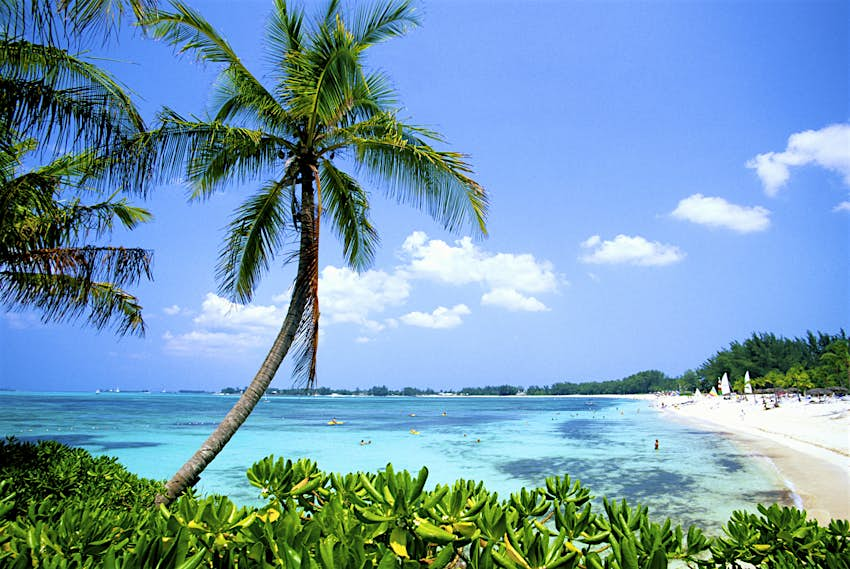 The Bahamas reopened its borders on July 1 © Hisham Ibrahim / Getty Images
The Bahamas reopened its borders on July 1 © Hisham Ibrahim / Getty Images
The Bahamas
The Bahamas officially reopened its borders on July 1, but suspended travel from the US on July 22, due to a spike in American COVID-19 cases. The ban was lifted less than a week later, but visitors must quarantine for 14 days upon arrival.
Visitors must adhere to the country’s safety protocols which include presenting a “COVID-19-PCR Negative (Swab) Test” taken no more than 10 days prior to the date of arrival.
All travelers will be required to complete an electronic Health Visa before departure. Each traveler will need to upload their test results and provide contact information that is crucial for contact tracing purposes.
At airports and seaports, healthcare personnel will conduct temperature screenings for all incoming visitors. Travelers will be required to wear a face mask in any situation where it is necessary to enforce physical distancing guidelines, such as when entering and transiting air and sea terminals, while navigating security and customs screenings, at baggage claim and during the full duration of a tax ride.
Barbados
Barbados reopened its borders to tourists on July 12. Visitors from high-risk countries (those with more than 10,000 new cases in the prior seven days) are encouraged to take a COVID-19 PCR test 72 hours before departure to Barbados. Visitors from low-risk countries can take a test within a week before their departure. Travel guidelines for entry into Barbados are based on the COVID-19 risk of each country.
All travelers must provide proof of a negative test and observe social distancing protocols and wear a face mask at the airport.
Applications are open for remote workers who want to move to Barbados for a year
Bonaire
On July 1 Bonaire opened its borders to travelers who have quarantined for 14 straight days in one of these low-risk countries: Belgium, Germany, Switzerland, France and the Netherlands. Visitors must adhere to the country’s thorough COVID-19 protocols. Among them include signing a health declaration, taking a PCR-test 72 hours before arrival, wearing face masks and practicing social distancing.
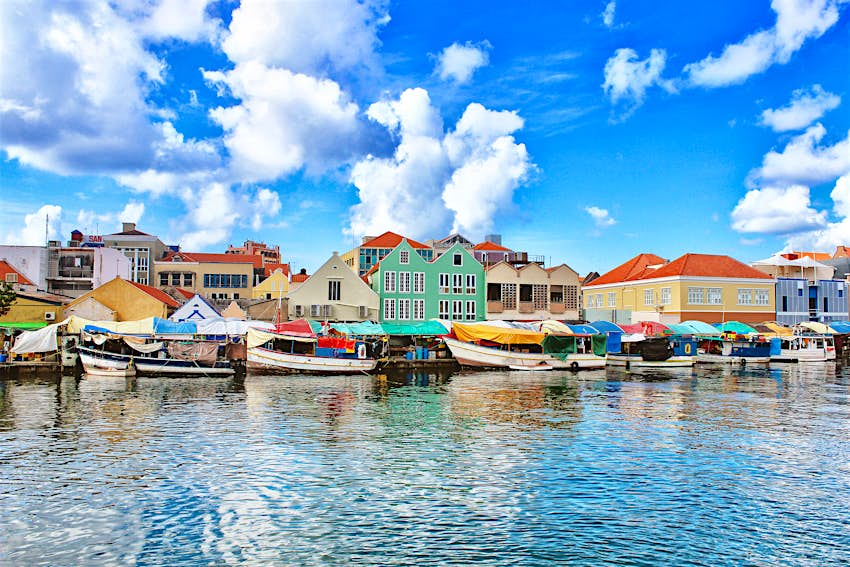 Curaçao reopened it borders with strict passenger limits from certain countries © larigan – Patricia Hamilton/Getty Images
Curaçao reopened it borders with strict passenger limits from certain countries © larigan – Patricia Hamilton/Getty Images
Curaçao
As of July 1, Curaçao reopened its borders to a maximum of 10,000 passengers from Austria, Canada, China, Cuba, Czech Republic, Denmark, Germany, Finland, France, Greece, Guyana, Hungary, Italy, Netherlands, New Zealand, Norway, Poland, Switzerland, Taiwan, Turkey, Turks and Caicos, Uruguay, United Kingdom. Countries not included on the list are seen as high-risk and will require visitors quarantine for 14 days.
According to Curaçao’s website, before arrival, visitors must complete a digital immigration card, fill out a “Passenger Locator Card” (PLC) and provide a negative result from a certified COVID-19 PCR-test. Travelers must provide printed copies for both the PLC and the test result.
Once on the island, visitors are expected to follow the standard social distancing practices and wear a face mask in those instances when distancing is not possible. Hospitality facilities are open, along with, bars, restaurants and beach clubs. Just make a reservation in advance.
Editor’s note: A travel bubble has been established between the countries of Aruba, Bonaire and Curaçao.
Cuba
A recent surge in COVID-19 cases in Havana has caused reopening plans to stall in Cuba. In late June, the country announced that visitors could travel to the island, but would be isolated from locals. After getting tested at the airport, travelers who tested negative would be moved to the country’s outlying island resorts on Cayo Coco, Cayo Guillermo, Caya Santa Maria and Caya Largo del Sur, according to Timeout. Travelers will not be allowed to visit Havana.
Dominica
The Nature Island reopened to tourists on Aug. 7. According to Dominica’s Tourism board, health and safety protocols include:
“All travelers must submit a health questionnaire online at least 24 hours before arrival, show notification of clearance to travel and submit a negative PCR test result recorded within 24-72 hours before arrival.
Upon arrival, visitors must wear face masks during the entire arrival process, observe social distancing guidelines, practice good respiratory and personal sanitization and follow all instructions of healthcare staff and officials.”
Visitors will be expected to follow proper health and safety protocols during the entire stay.
Dominican Republic
The Dominican Republic reopened its borders to visitors on July 1.
Visitors must present a negative COVID-19 PCR test within five days of arrival. Other health and safety protocols include wearing a mask in public areas and adhering to the curfew hours (7pm to 5am Monday-Friday and 5pm to 5 am on the weekend).
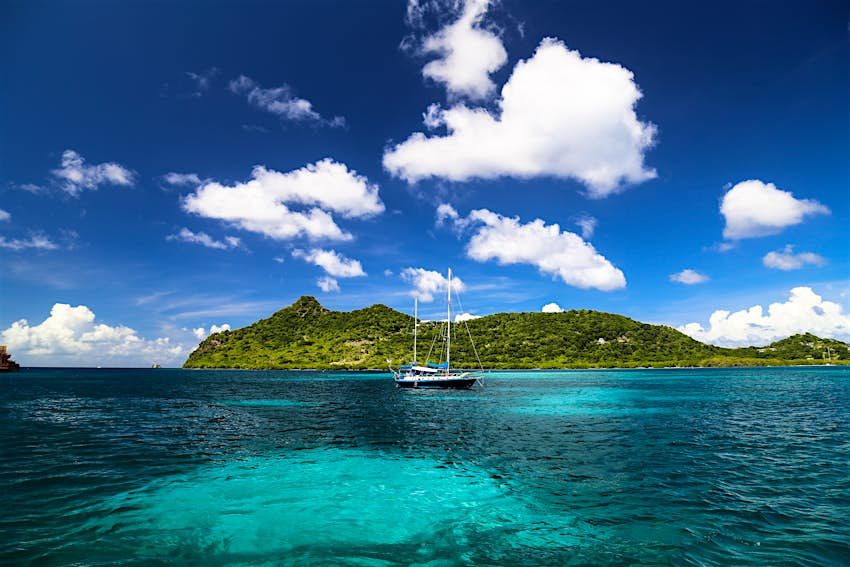 Grenada has a three-tired entry policy for visitors © Petronella Pieprz/500px
Grenada has a three-tired entry policy for visitors © Petronella Pieprz/500px
Grenada
Grenada officially reopened its borders to international travelers on July 15. The country has set up a three-tiered health and safety protocol system based on whether a visitor is coming from a low risk, medium risk or high-risk country. The numbers are based on “Covid-19 14-day case notification rate per 100,000 population”.
Everyone is required to download Grenada’s contact tracing app before departure. According to the country’s travel advisory website, face masks are required in public places while practicing social distancing.
Guadeloupe
Guadeloupe reopened its borders to mainland France in early June and the rest of the world (except for the United States) on July 1. A travel ban on Americans will remain in effect under further notice, according to the Guadeloupe website.
For those who can visit the country, travelers are expected to provide a negative result from a COVID-19 PCR test certificate 72 hours before departure, wear face masks and practice social distancing.
Haiti
Haiti officially reopened on June 30 when the Toussaint Louverture Airport officially reopened for business. On July 27, the country lifted its state of emergency.
All international visitors to the country must declare their COVID-19 status via an incoming flight form, will get temperature screened upon arrival and are required to quarantine for 14 days. There has been no ban on travelers from any country, but face masks are required in all places of business and on public transport.
Jamaica
Prime Minister Andrew Holness officially opened his country’s borders to tourists on June 15. Jamaica’s “re-entry protocols” factor in the risk level of where travelers are arriving from. Travelers from high-risk countries will be required to submit a negative COVID-19 PCR test within 10 days of arrival, while travelers from low-risk countries may be required to a swab test upon arrival.
“Health and safety are paramount as we reopen our tourist industry on a phased basis,” says Donovan White, Jamaica’s Director of Tourism via a press release. “Risk assessment is an important part of preventing further spread of COVID-19 and ensuring that our visitors and residents stay safe. We have developed and are implementing procedures throughout the visitor journey that ensure a seamless process so they are able to enjoy what our island and its people have to offer.”
All travelers are required to fill out and download a Travel Authorization Application.
 Puerto Rico has postponed its reopening date © Ed Adams / 500px
Puerto Rico has postponed its reopening date © Ed Adams / 500px
Puerto Rico
After seeing spikes in COVID-19 cases, Puerto Rico officially postponed reopening its borders to tourists. The original reopening date was slated for July 15 but has been pushed back. Currently, only essential travel is encouraged. The country has placed restrictions on restaurant capacity and instituted a 10 pm to 5 am curfew. Bars, clubs, casinos and theaters remain closed.
St. Barth
The island of St-Barthélemey reopened to tourists on June 22. According to a press release from the President of the Territorial Council, Bruno Magras, visitors will be required to present a negative RT-PCR COVID-19 test 72 hours before departure. For travelers staying more than seven days, a second test will be required on day eight.
St. Kitts and Nevis
St. Kitts and Nevis Prime Minister, Dr. Timothy Harris announced during a press conference that the country is eyeing an October reopening for international visitors.
The Ministry of Tourism and the Ministries of Health and Civil Aviation will work together to train 5,000 people in the tourism sector to implement a series of new health and safety protocols to combat COVID-19.
St. Lucia
St. Lucia opened its borders to international travelers on June 4. According to the country’s entry requirements, all visitors must present a negative PCR COVID-19 test taken no later than seven days before arrival. Visitors must also fill out and travel with a copy of a Pre-Arrival Registration Form. Upon arrival, all travelers will be required to take a temperature check. Other health protocols include wearing face masks in common areas, using COVID-19 certified taxis and hotels and practicing social distancing.
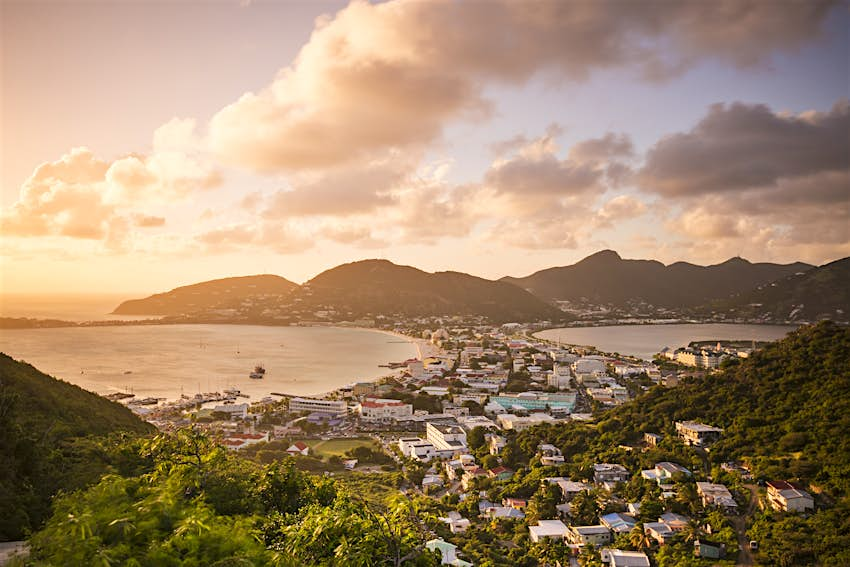 Cityscape at the Great Salt Pond in Sint Maarten © Sean Pavone / Shutterstock
Cityscape at the Great Salt Pond in Sint Maarten © Sean Pavone / Shutterstock
Sint Maarten
The country officially reopened to international travelers from Canada and Europe on July 1 and began welcoming US travelers on August 1.
According to Sint Maarten’s website, visitors “are required to take a COVID-19 PCR test and receive negative results within 72 hours prior to departure. Incorrect tests are subject to retesting on site” and will cost $125USD. All travelers must fill out a health declaration form, wear a mask inside the airport and take a mandatory temperature check upon arrival. While on the island, visitors are expected to practice social distancing and wear face masks when that’s not possible.
Only Americans traveling for professional or medical reasons will be allowed to cross to the French side of the island, according to Travel Weekly.
St. Martin
Due to a spike in COVID-19 cases, St. Martin banned US travelers from crossing the border until further notice, according to The Daily Herald. Like Sint Maarten, international visitors are required to complete a health declaration form, provide a negative COVID-19 PCR test, wear face masks and submit to a temperature check upon arrival.
Saint Vincent and the Grenadines
Saint Vincent and the Grenadines reopened its borders on August 1. Travelers who arrive in the country must sign a Pre-Arrival Form. Entry health and safety protocols are based on the COVID-19 risk level of the country. All travelers will be tested upon arrival and must quarantine for at least 24 hours pending COVID-19 test results.
American travelers are subjected to very strict protocols upon arrival.
Turks and Caicos
Turks and Caicos reopened its borders on July 22. The Providenciales International Airport resumed international travel in late July, though the Grand Turk Cruise Center remains closed.
The new health and safety protocols require travelers to present a negative COVID-19 PCR test taken within five days of arrival, upload and register for TCI Assured, “a quality assurance pre-travel program and portal” according to a Turks and Caicos press release. Travelers must also ” have medical / travel insurance that covers medevac (insurance companies providing the prerequisite insurance will also be available on the portal), a completed health screening questionnaire, and certification that they have read and agreed to the privacy policy document.”
All visitors must wear a mask when traveling in public and a nightly curfew (10pm to 5am) has been imposed for Providenciales and North Caicos.
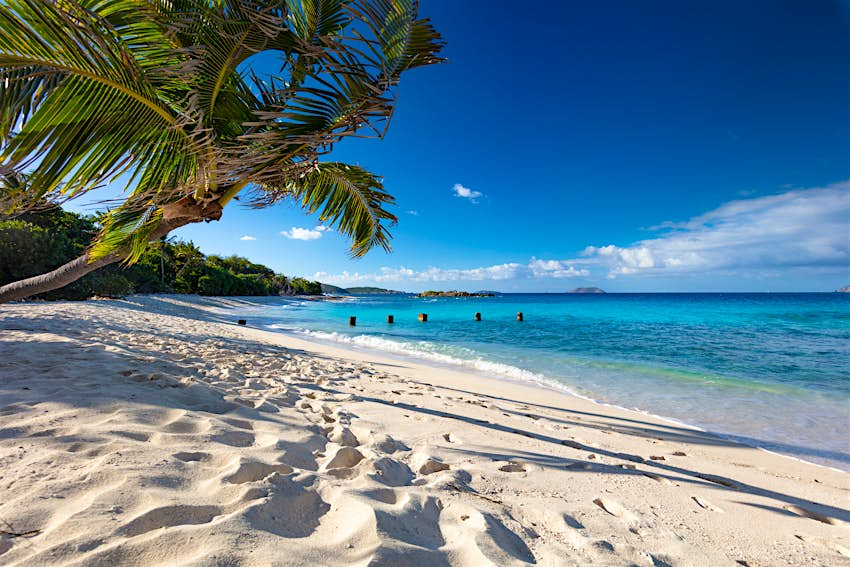 The US Virgin Islands opened to international travelers on June 1 © Getty Images / iStockphoto
The US Virgin Islands opened to international travelers on June 1 © Getty Images / iStockphoto
US Virgin Islands
The US Virgin Islands reopened to “leisure travelers” on June 1. According to the country’s travel guidelines, all travelers must complete a Travel Screening within five days of travel. Travelers arriving from residences where COVID-19 positivity is more than 10 percent will be required to provide a negative COVID-19 antigen result within five days of arrival or provide a positive COVID-19 antibody test result received four months before arrival. All travelers must wear a facial covering upon arrival.
There will be mandatory temperature checks for everyone before entering the country.
North Atlantic Ocean
Bermuda
The island of Bermuda opened its borders to tourists on July 1. In response to COVID-19, the country instituted a series of protocols for travelers before arrival, upon entry and when departing. According to Bermuda Tourism Authority’s press release:
Prior to departing for Bermuda, travelers should:
Obtain a certified negative PCR COVID-19 test within 72 hours of departure
Ensure they have appropriate health insurance
Wear face masks when traveling to the departure airport
Wear face masks and practice physical distancing at the departure airport
Complete a traveler screening form and arrival card
Upon arrival, travelers should:
Wear a facemask and practice social distancing
When departing Bermuda, travelers should:
Pre-boarding health screening in the form of a temperature check will be conducted if your destination jurisdiction requires it.
“… Now more than ever, we believe travelers will value our genuine hospitality, pristine beaches and open spaces,” said Glenn Jones, interim CEO of the Bermuda Tourism Authority via a press release. “The Bermuda government’s plan is rigorous: protecting the health of our community while allowing visitors to experience our island safely and responsibly when they are ready to travel.”
Flights
Major airlines all over the globe are slowly resuming flights to various countries throughout the Caribbean. In June, Delta Air Lines announced flights to Aruba; Bermuda; Bonaire; Kingston and Montego Bay, Jamaica; Nassau, Bahamas; Turks and Caicos; Punta Canan and Santo Domingo, Dominican Republic; San Juan, Puerto Rico; St. Croix; St. Maarten and St. Thomas. While
American Airlines is heading to like St. Kitts, Dominican Republic, Aruba, The Bahamas and Cayman Islands.
This article was first published on May 22 and updated on August 2020.
This article first ran on our sister site, Lonely Planet.
